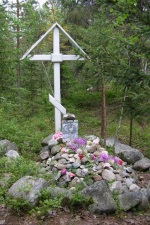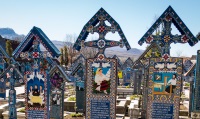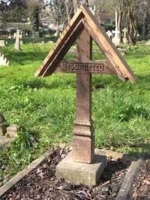Roofed Cross
or Capped Cross
This style tends to be used mostly for gravestones, war memorials and wayside crosses.
They are not unique to any particular denomination; Roman Catholics, Protestants, East Orthodox and even cross-denying Mormons!
The styles also are varied; plain Latin, with or without a corpus, multi-barred Eastern Orthodox, etc. Crosses with "roofs" can be found all over the world, and especially in Europe.
North
Even in the very north, where few people live, the crosses exist.
On the icy Solovetsky Islands you can visit the example on the right, where the roof is certainly needed to protect the cross in the heavy winter snow.
This Eastern Orthodox cross overlooks the grave of the reburied remains of an unknown prisoner who died in the 1920s in Solovki, a Gulag created by Stalin and one of the USSR's most notorious prison camps.
East
In Tatarstan and other parts of Russia are several other examples, as shown on the scottcorner.org webpage. There we can see crosses found on the graves of Old Believers and of Russian Mormons.
The most elaborate roofed crosses can be seen in Romania, at the Merry Cemetery in Sapanta, Maramures. What's merry about death? There's plenty, for those who follow the early Christian tradition of celebrating the commendation of their loved one's soul to God.
South
Nenad Bačilović in Serbia showed us further wooden roofed crosses he found at a cemetery at Rudna Glava (Рудна Глава гробље) in eastern Serbia.
"Rudna Glava" translates as "ore head", and it is here that copper has been mined since 5th millennium BC, making it one of the earliest copper mines in Europe. It is quite possible that the sloping roofs of crosses there were originally covered with copper sheets.
And further south in Italy are some fabulous examples, photos of which we hope to include here soon.
West
Grave markers such as the one shown on the right, can be found in the churchyard of Ss Mary & John, an Anglican church in Cowley, Oxford, England.
These oak crosses date from the 1890s to the 1930s. The sloping roofs were originally covered with lead – a material easily ripped off and resold by thieves. Some of the crosses have carvings and a few appear to have had a corpus attached at some time.
Meaning
As with all symbols, and crosses in particular, the meaning is whatever it means to you. For example, the triangle formed by the roof and the crossbar could be seen as reference to the Holy Trinity. Alternatively it could be viewed as a symbolic enclosure, representing the tomb of the Resurrection, or perhaps the outline of a church.
A common interpretation is more pragmatic; a roof, actual or symbolic, to protect the cross from snow and rain. It's easy to understand why Christians want to protect an image of the Cross, just as comfort is gained from remembering that the Cross itself offers protection for us all.
The interpretation that we favour, however, is from noticing that the roof's eaves almost invariably overhang the cross arms slightly, forming a big letter "A". This reminds us of the Divinity of Jesus Christ:
As noted on the Alpha and Omega page, Alpha represents the existence of God before time, before the beginning of anything, a concept we are unable to grasp.
The omission of the Omega (beyond the end of time) from the roofed cross reminds us that The End is yet to come. Whether physically dead or alive, we are still in the living phase of God's plan.
And this gives us hope.
The term "capped" should not be confused with the Capital Cross.
The remains were discovered and reburied in 1990.




